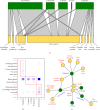Multihost/Multivector Community Network: Disentangling Sandfly Species and Host Interactions in Avian Habitats
- PMID: 40303103
- PMCID: PMC12016980
- DOI: 10.1155/tbed/9259030
Multihost/Multivector Community Network: Disentangling Sandfly Species and Host Interactions in Avian Habitats
Abstract
Ascertaining the feeding behavior of vectors is a key for understanding epidemiology of the infections they transmit. For some host-vector-parasite systems, this information is biased towards human and peridomestic habitats, frequently underestimating the likely role of wildlife. In addition, studies on vector interactions often focus on a one-to-one host-vector relationship, even though it is crucial to analyze how multiple vector species interact with multiple hosts. These biases particularly affect our knowledge of sandflies, the main vector of Leishmania spp. and various phleboviruses, that are rarely explored in non-peridomestic habitats and in the context of multiple interactions with various hosts. To reveal the multihost/multivector network involving phlebotomine sandflies in a semiarid and poorly populated area of Spain, we sampled the sandfly community close to avian nests by means of two trapping methods (Centers for Disease Control (CDC) and sticky traps) during 3 years and identified the blood-meal source of all engorged sandflies. We detected six phlebotomine species with Phlebotomus perniciosus, P. papatasi, and Sergentomyia minuta being the most abundant ones. We identified 13 blood source species, with humans being the most common one, followed by Coracias garrulus (European roller) and Sus scrofa (likely wild boar). Five of the six sandfly species fed largely on wild mammals, although, three also fed on wild birds. Phlebotomus sergenti only fed on birds based on this analysis. Phlebotomus papatasi and P. sergenti were common visitors of bird nests suggesting an endophagic behavior. A network analysis showed a highly-connected and poorly-specialized network wherein sandflies shared most of the blood source and showed an opportunistic feeding behavior with marked anthropophilia. Our results obtained close to avian nests show that sandfly populations are maintained by various wild animals, which will greatly complicate the management and control of the pathogens they transmit to humans and domestic animals.
Keywords: anthropophilia; arid areas; blood meal; endophagy; phlebotomine; vector-borne.
Copyright © 2024 J. Veiga et al.
Conflict of interest statement
The authors declare no conflicts of interest.
Figures



Similar articles
-
Molecular Identification of Host Blood Meal from Phlebotomine Sandflies (Diptera: Psychodidae) from Kerala, India.Vector Borne Zoonotic Dis. 2024 Dec;24(12):808-816. doi: 10.1089/vbz.2023.0168. Epub 2024 Jul 27. Vector Borne Zoonotic Dis. 2024. PMID: 39066720
-
Seasonal phenology, host-blood feeding preferences and natural Leishmania infection of Phlebotomus perniciosus (Diptera, Psychodidae) in a high-endemic focus of canine leishmaniasis in Rome province, Italy.Acta Trop. 2008 Feb;105(2):158-65. doi: 10.1016/j.actatropica.2007.10.005. Epub 2007 Oct 18. Acta Trop. 2008. PMID: 18035329
-
Phlebotomine sand fly survey in the focus of leishmaniasis in Madrid, Spain (2012-2014): seasonal dynamics, Leishmania infantum infection rates and blood meal preferences.Parasit Vectors. 2017 Aug 1;10(1):368. doi: 10.1186/s13071-017-2309-z. Parasit Vectors. 2017. PMID: 28764772 Free PMC article.
-
[Prevention and control of leishmaniasis vectors: current approaches].Parassitologia. 2004 Jun;46(1-2):211-5. Parassitologia. 2004. PMID: 15305719 Review. Italian.
-
Natural breeding places of phlebotomine sandflies.Med Vet Entomol. 2004 Mar;18(1):71-80. doi: 10.1111/j.0269-283x.2004.0487.x. Med Vet Entomol. 2004. PMID: 15009450 Review.
Cited by
-
Seroepidemiological Surveillance of Livestock Within an Endemic Focus of Leishmaniasis Caused by Leishmania infantum.Animals (Basel). 2025 May 22;15(11):1511. doi: 10.3390/ani15111511. Animals (Basel). 2025. PMID: 40508979 Free PMC article.
-
Updating the distribution of sand flies in Hungary with implications on their biology and ecology.Curr Res Parasitol Vector Borne Dis. 2025 Jul 8;8:100293. doi: 10.1016/j.crpvbd.2025.100293. eCollection 2025. Curr Res Parasitol Vector Borne Dis. 2025. PMID: 40689039 Free PMC article.
References
-
- Lehane M. J. The Biology of Blood-Sucking in Insects . 2nd. Cambridge University Press; 2005. - DOI
-
- Nunn C. L., Vining A. Q., Chakraborty D., Reiskind M. H., Young H. S., Becker D. Effects of Host Extinction and Vector Preferences on Vector-Borne Disease Risk in Phylogenetically Structured Host-Hector Communities. PLoS ONE . 2021;16(8) doi: 10.1371/journal.pone.0256456.e0256456 - DOI - PMC - PubMed
MeSH terms
LinkOut - more resources
Full Text Sources
Miscellaneous

